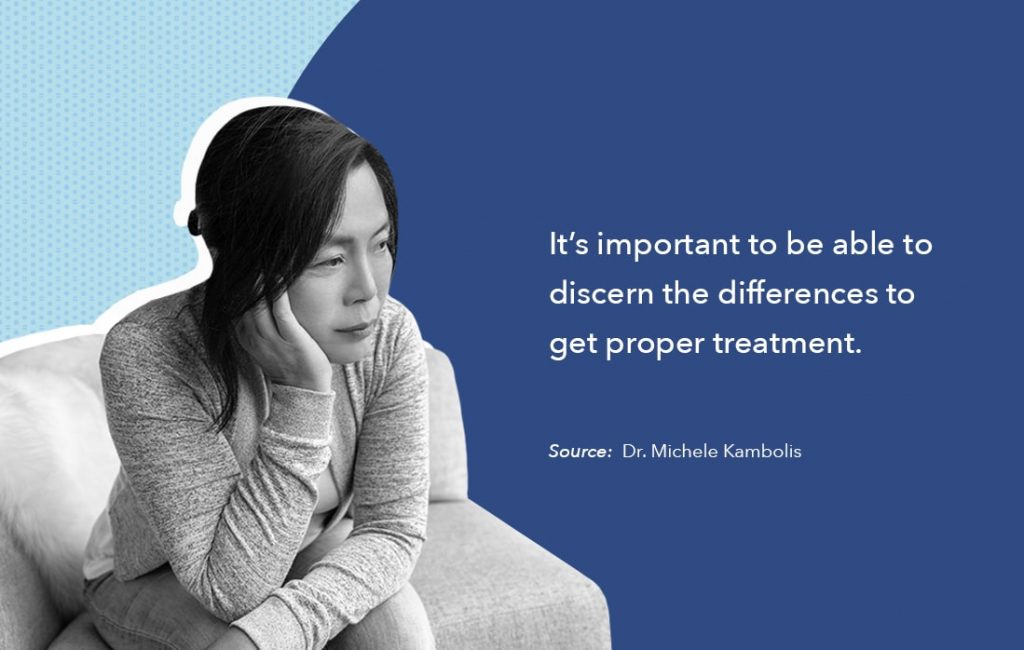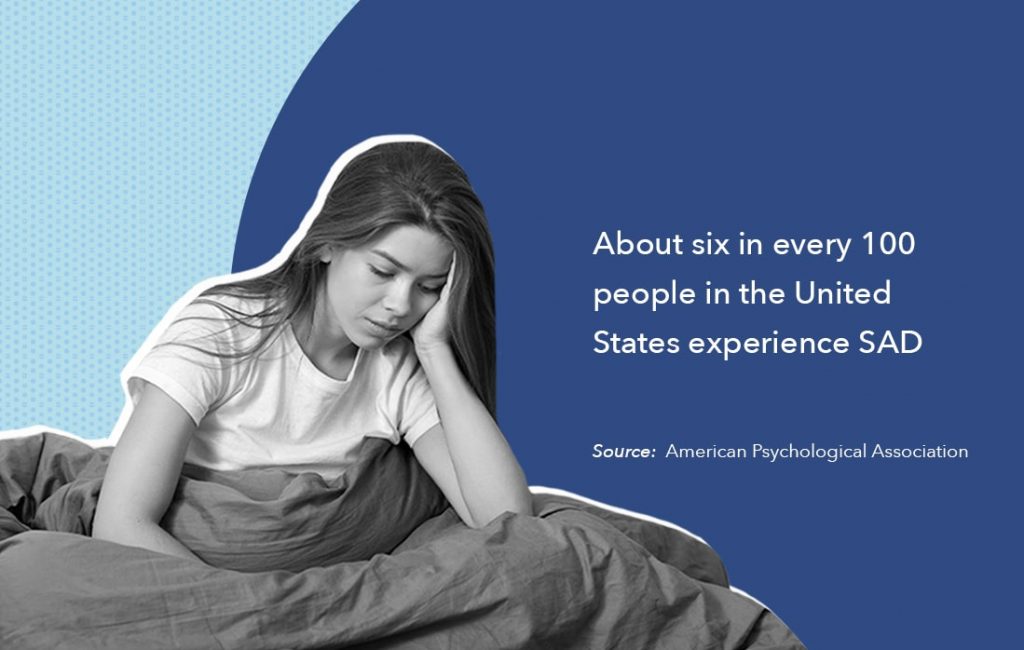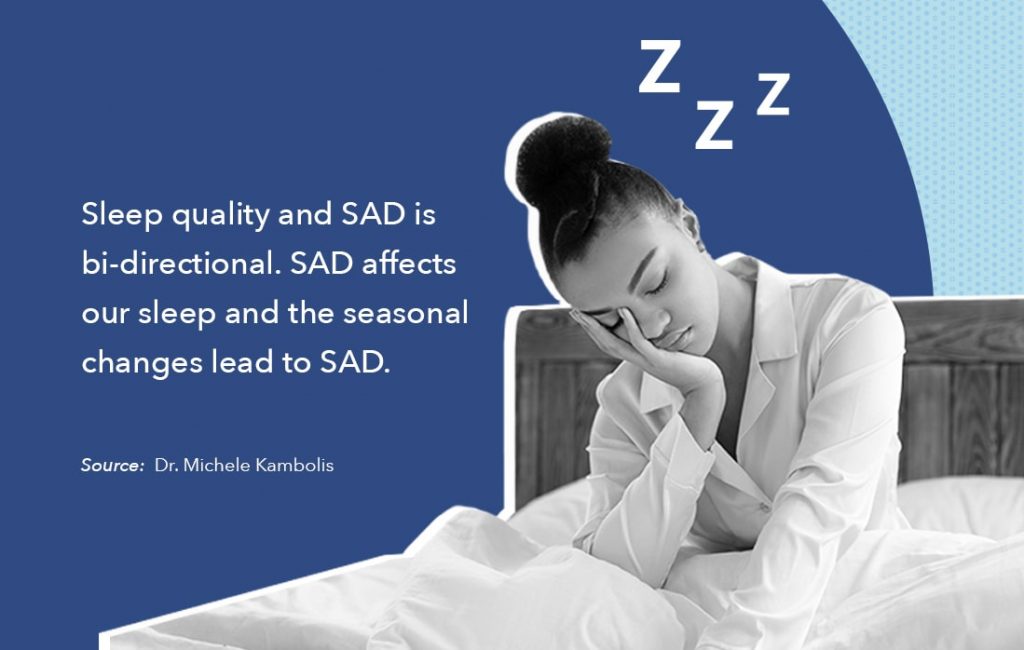Seasonal depression is a type of depression in which people experience feelings of sadness, hopelessness, and/or listlessness for an extended period during a particular portion of the year. Sufferers tend to experience these feelings for four or five months a year, and they will typically be in the winter months. Like most forms of depression, seasonal depression is often associated with sleep problems.
In this article, I’ll explain seasonal depression, its symptoms, and various treatment methods. Please keep in mind these general recommendations should not be taken as medical advice. If you have any health-related questions regarding depression and/or sleep, consult your physician or a trained medical professional.
Note: The content on Sleepopolis is meant to be informative in nature, but it shouldn’t be taken as medical advice, and it shouldn’t take the place of medical advice and supervision from a trained professional. If you feel you may be suffering from any sleep disorder or medical condition, please see your healthcare provider immediately.
What is Seasonal Depression?
Seasonal Depression, also known as Seasonal Affective Disorder (SAD), is a type of depression that is recurrently affected by the change in seasons. According to Psychologist Dr. Megan Rhoads, PsyD, “The main difference between SAD and Major Depressive Disorder is that SAD only occurs with the change in seasons and therefore, the amount of sunlight we encounter.”
The vast majority of those with SAD will experience changes in mood in the winter months (winter-pattern SAD), but these changes can also happen during the summer months (summer-pattern SAD). (1)

Though lower levels of sunlight lead many to experience feelings of sadness and tiredness in the winter months, SAD is characterized by sharp changes in mood. About six in every 100 people in the United States experience SAD. (2) These individuals will experience overwhelming symptoms that affect their ability to complete tasks and interact with others.
Signs of Seasonal Depression
If you’re concerned that you or a loved one might be experiencing seasonal depression, it can be important to look for signs of the condition. Licensed Clinical Counselor Jennifer Browning recommends keeping an eye out for these telltale signs:
- Less involvement in daily activities
- Lack of care for personal appearance or hygiene
- Changes in eating habits
- Changes in sleep patterns
- Decreased attention paid to work
- Less care put into personal relationships
It can be easy to confuse seasonal depression with major depressive disorder (MDD), as both conditions can be characterized by similar symptoms. However, discerning between the two is key to getting the right treatment. Dr. Michele Kambolis, a mind-body health specialist and registered therapist, shared the distinct symptoms that characterize each condition, listed below.

SAD Symptoms
- Hypersomnia (excessive sleeping)
- Hyperphagia (increased appetite)
- Carbohydrate cravings and weight gain
- Begins in the fall and continues until the end of winter
MDD Symptoms
- Insomnia
- Reduced appetite and possible weight loss due to loss of appetite
- Can occur during any time of the year
Additionally, summer-pattern SAD has different symptoms than winter-pattern SAD. These include:
- Insomnia
- Loss of appetite
- Weight loss
- Anxiety
How to Manage Seasonal Depression
Though sufferers may experience symptoms of seasonal depression each year with the change in seasons, there are several ways to manage the condition. Our experts have recommended a number of behavioral changes, therapies, and supplements that can have a great impact on the severity of symptoms.

Go for a walk during the daytime hours for at least 30 minutes
Exposure to sunlight makes your body produce vitamin D3, which has been shown to decrease depression. (3) Additionally, according to Browning, “walking 30 minutes a day has been known to increase mood and fight off the feelings and thoughts around depression.”
Have a set bedtime and wake time
By choosing a specific time to go to sleep each night, you train your body to become tired and wakeful at specific times, which helps reset your circadian rhythm or natural sleep/wake cycle.
Make sure to expose yourself to adequate light
“Light therapy is really important,” says Dr. Shelby Harris, Sleepopolis’ director of sleep health. “It’s something you definitely want to talk to your doctor about if you do think there’s a seasonal component to any depression that you’re having. It would be getting a light box, making sure your eyes are okay, trying to use the light at very prescribed times that your doctor has told you.”
Harris says combating seasonal depression is really about “bathing your brain in light.” Options beyond using a light box include:
- Opening the blinds as soon as you wake up and trying to sit near a window during the day.
- Taking breaks throughout the morning to get outside and spend time in the sunlight.
- Purchasing a dawn light alarm clock, which will simulate a sunrise by producing increasing amounts of light to coincide with your wake time.
- Keeping the lights on in the afternoon and evening, staying active and trying not to go to bed too early.
Try a supplement
- Vitamin D3 increases the production of serotonin (the feel good chemical). You can also look for foods that are high in vitamin D, like mushrooms, to incorporate into your diet.
- Melatonin helps regulate your sleep-wake cycle and helps you fall asleep.
- Magnesium works with melatonin to regulate sleep wake cycles.
- Gaba is a neurotransmitter known as the “brakes of the brain,” according to Dr. Kambolis. It can be found in supplement form or in foods like green tea, kimchi, and miso.
Take care of yourself
- Self-care practices like meditation and breathing exercises have been shown to improve mood.
- Show self-compassion. “Self-compassion is the active practice of directing empathy directly towards yourself. All it requires is that you pause, notice what’s happening and direct some kindness to yourself,” says Dr. Kambolis.
- Reach out for help through counseling.
Practice good sleep hygiene
Good sleep hygiene refers to the practices you follow to get a good night’s rest. These practices include:
- Make sure you’re only using your bed for sleeping and sex.
- Don’t use smart devices at least 30 minutes before bed.
- Abstain from alcohol and caffeine at least 3 hours before bed.
- Exercise regularly for a combined total of 150 minutes/week
- Make sure you’re sleeping on a quality mattress that is right for your needs. If you’re experiencing aches and pains, you might want to opt for a soft mattress.
Seasonal Depression and Sleep
Depression of all kinds has been linked to sleep problems, and seasonal depression is no different. However, sleep problems linked to SAD are a bit different than those linked to other types of depression. According to Dr. Kambolis, “Sleep quality and SAD is bi-directional. SAD affects our sleep (either leaving us sleeping too little or too much) and the seasonal changes lead to SAD (in particular the lack of sunlight can lead to SAD).”

Additionally, Dr. Kambolis explains that our sleep quality has a lot to do with our circadian rhythms. Our circadian rhythms are affected by both our chronotype (our own unique sleep/wake cycle) (4) and the light-sensitive cells in our retinas. The change in light that occurs as the seasons change affects the amount of light that hits our retinas, which therefore affects our circadian rhythms.
Browning shared a similar thought about sleep patterns and suggested ways to combat these changes. “Sleep can be greatly affected by seasonal depression by changing our routine and getting in the way of our bodies realizing rest is needed.” When our bodies aren’t realizing rest is needed, we suffer from sleep deprivation, which throws off our internal clock. This leads to staying up later, feeling exhausted, and not wanting to get up in the morning.
Browning says that the best way to break this harmful cycle is to set an alarm and stick to it, even if you don’t feel like getting up at that time. You still may not go to bed at your desired time that night, but if you do this consistently enough, you should be able to reset your internal clock.
Causes of Seasonal Depression
Though seasonal depression is relatively common, its exact cause is not known. Dr. Kambolis cited a study that found SAD to be more common in women than men, and that it worsens menstrual symptoms for women during the depressive months. Though seasonal depression can occur in both the winter and summer months, it occurs far more often in winter. The symptoms for winter-pattern SAD and summer-pattern SAD are different, but they have similar causes related to the change in seasons, including:
- Offsetting of circadian rhythm. The change in sunlight can disrupt your body’s internal clock, which can lead to feelings of depression (winter SAD) or insomnia (summer SAD).
- Change in serotonin levels. Less sunlight can lead to a drop in serotonin levels, leading to depression. Increased sunlight can increase serotonin, which can lead to anxiety.
- Change in melatonin levels. The changes in light levels during the seasons can affect the body’s production of melatonin, causing it to produce too much in the darker winter months (leading to excessive sleeping) and not enough in the lighter summer months (inability to sleep). (5)
Last Word From Sleepopolis
Seasonal depression, or SAD, is a unique depressive condition. It is correlated to the change in daylight levels during seasonal shifts and can occur in both the winter and summer months. Though it isn’t possible to “cure” SAD, it is possible to mitigate its effects through spending time outside when possible, taking supplements like vitamin D3, using a light therapy box, and practicing good sleep hygiene.
References
- American Psychological Association. (n.d.). Speaking of psychology: How to know if you have seasonal affective disorder. American Psychological Association. Retrieved November 4, 2021, from https://www.apa.org/research/action/speaking-of-psychology/seasonal-affective-disorder.
- Kalmbach, D. A., Schneider, L. D., Cheung, J., Bertrand, S. J., Kariharan, T., Pack, A. I., & Gehrman, P. R. (2017, February 1). Genetic basis of chronotype in humans: Insights from Three landmark gwas. Sleep. Retrieved November 4, 2021, from https://www.ncbi.nlm.nih.gov/pmc/articles/PMC6084759/.
- Mayo Foundation for Medical Education and Research. (2017, October 25). Seasonal affective disorder (SAD). Mayo Clinic. Retrieved November 4, 2021, from https://www.mayoclinic.org/diseases-conditions/seasonal-affective-disorder/symptoms-causes/syc-20364651.
- Penckofer, S., Kouba, J., Byrn, M., & Estwing Ferrans, C. (2010, June). Vitamin D and depression: Where is all the sunshine? Issues in mental health nursing. Retrieved November 4, 2021, from https://www.ncbi.nlm.nih.gov/pmc/articles/PMC2908269/.
- U.S. Department of Health and Human Services. (n.d.). Seasonal affective disorder. National Institute of Mental Health. Retrieved November 4, 2021, from https://www.nimh.nih.gov/health/publications/seasonal-affective-disorder.



























